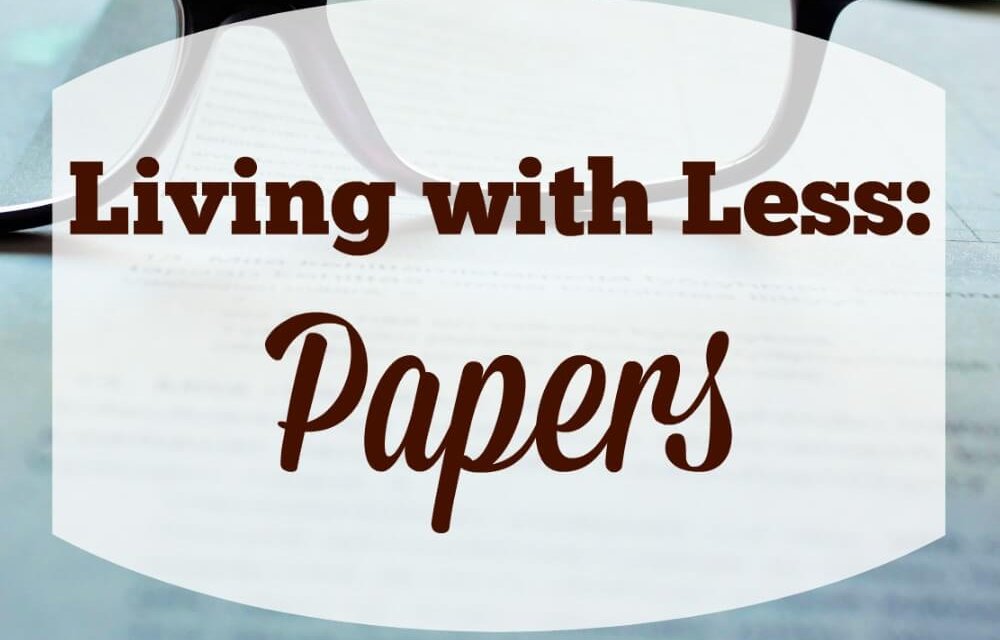Paper is one of the trickiest things to control in our homes because, whether we ask for it or not, more and more shows up every day. Bills, notices, solicitations, coupons, flyers… and that’s just the mail! There’s also all the paper you bring home (which, as a teacher, is a considerable amount), notes you leave yourself, and the newspaper article about that thing happening in that place that you’ll probably never go to. And then, there are kids. Kids bring with them a whole new set of paper problems.
I think the overwhelming amount of paper coming home from preschool was the thing that I was least prepared for when Miss O started school. They literally sent home every piece of paper she so much as drooled on and it was insane. Every day there were a dozen or so “drawings” coming home. They were everywhere! They were in my car, in the basement, on the dining room table, the kitchen counter… you get the idea.
Then, of course, there’s the bills.
Oy.
Pick a day, any day
For a long time I was completely overwhelmed by grown-up mail. It was constant. And none of it was fun.
I would open the envelopes, look at the contents, get depressed, and put it in a pile. And while my electricity never got shut off, I did miss a few payments, and I had no idea how much I was spending.
I needed a system.
Now things are much easier (though I still miss the fun mail I got when I was a kid). First, I put as many bills as possible on auto-pay. Things like trash collection, cable, cell phone, and my daughter’s dance class are a fixed amount each month, which makes them perfect for auto-pay.
The next thing I did was set up an organizer with 3 folders; household bills, health bills, and easy access. Any bills related to running our house go in the household folder. All health-related bills, co-pays and deductibles, go in the HSA folder. And anything that we need to get to regularly, like insurance documents go in the easy access folder.
Household bills get paid on Thursday nights. Health bills get paid on Mondays. And I’m no longer drowning in paper.
Bills. Bills. Bills.
Once the bills are paid, the question is what to do with them. There are different schools of thought on this – some say to keep records for a year, others say it’s 6 months, others say don’t bother. Personally, I don’t keep my bills. I’m sure the financial gurus would have something to say about this, but since I have electronic records of everything… I just can’t make myself do it.
Whatever you do, you’re going to need a safe way to get rid of old papers, especially those with any financial information on them. I highly recommend this Amazon Basics Shredder. It cross shreds paper tho make it harder for identity thieves to steal your information, and the pull-out basket makes it easier to empty.
Macaroni, and glue, and crayons… oh my
And then there’s the kid’s stuff. Between artwork, projects, homework, and of course, fundraisers, it’s a mess. A friend of mine recently said she kept everything from her daughter’s kindergarten year in a big box. Everything. I just don’t have the mental capacity to do that. And honestly, I don’t want to.
What works for us is a 2-part system. First I take the art or work that’s really good and hang them up in the play room. There are only so many spaces, so when I hang something up, I take something else down. Anything with hand or foot prints is an automatic save, everything else is a judgement call. I generally toss typical worksheets, and save writing. Art work that is especially good or sweet (like when she drew our family with our dog floating above us after he passed) gets put in a storage bin.
If you’re feeling guilty about throwing out your kid’s work, you can always take pictures of each page and put them in an album, use one of the many picture/ artwork apps, or use a Picture Keeper to store them digitally and save the space in your home.
We’re never going to be able to stem the tide of paper coming into our homes, but with a little thought and some basic scheduling, it doesn’t have to take over your life.







